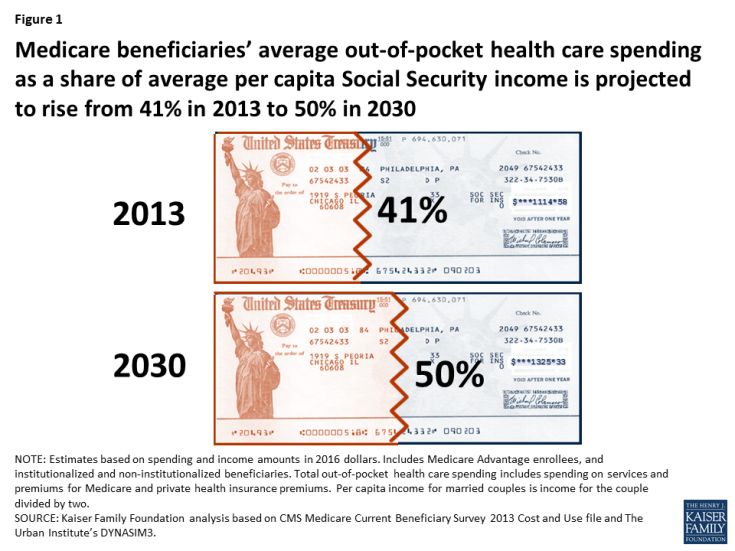Medicare Beneficiaries’ Out-of-Pocket Health Care Spending as a Share of Income Now and Projections for the Future
Medicare helps pay for the health care needs of 59 million people, including adults ages 65 and over and younger adults with permanent disabilities. Even so, many people on Medicare incur relatively high out-of-pocket costs for their health care, including premiums, deductibles, cost sharing for Medicare-covered services, as well as spending on services not covered by Medicare, such as long-term services and supports and dental care. The financial burden of health care can be especially large for some beneficiaries, particularly those with modest incomes and significant medical needs. Understanding the magnitude of beneficiaries’ current spending burden, and the extent to which it can be expected to grow over time, relative to income, provides useful context for assessing the implications of potential changes to Medicare or Medicaid that could shift additional costs onto older adults and younger people with Medicare.
In this report, we assess the current and projected out-of-pocket health care spending burden among Medicare beneficiaries using two approaches. First, we analyze average total per capita out-of-pocket health care spending as a share of average per capita Social Security income, building upon the analysis conducted annually by the Medicare Trustees. Second, we estimate the median ratio of total per capita out-of-pocket spending to per capita total income, an approach that addresses the distortion of average estimates by outlier values for spending and income. Under both approaches, we use a broad measure of Medicare beneficiaries’ total out-of-pocket spending that includes spending on health insurance premiums, cost sharing for Medicare-covered services, and costs for services not covered by Medicare, such as dental and long-term care. We present estimates of the out-of-pocket spending burden for Medicare beneficiaries overall, and by demographic, socioeconomic, and health status measures, for 2013 and projections for 2030, in constant 2016 dollars.
Key Findings
- In 2013, Medicare beneficiaries’ average out-of-pocket health care spending was 41 percent of average per capita Social Security income; the share increased with age and was higher for women than men, especially among people ages 85 and over.
- Medicare beneficiaries’ average out-of-pocket health care spending is projected to rise as a share of average per capita Social Security income, from 41 percent in 2013 to 50 percent in 2030 (Figure 1).
- Half of beneficiaries in traditional Medicare spent at least 14 percent of their per capita total income on out-of-pocket health care costs in 2013. The spending burden was higher for people ages 85 and over, in poor health, and with modest incomes.
- More than one-third (36 percent) of beneficiaries in traditional Medicare, and half of those with incomes below $20,000, spent at least 20 percent of their per capita total income on out-of-pocket health care costs in 2013. By 2030, more than 4 in 10 (42 percent) traditional Medicare beneficiaries are projected to spend at least 20 percent of their total income on health-related out-of-pocket costs.

